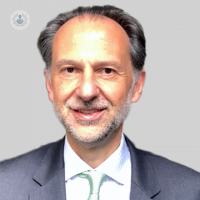How can benign prostate enlargement be treated?
Written by:In his previous article for Top Doctors, leading urologist Mr Marc Laniado discussed benign prostate enlargement (BPE), a condition affecting up to 80 per cent of men over the age of 70 in the UK. Here, he discusses how prostate enlargement can be treated, and how patients can make changes to manage the condition more comfortably.

How is BPE treated?
There are many treatments for an enlarged prostate depending on the amount of bother the symptoms cause and the physical configuration of the prostate.
Changes in lifestyle
For men with mild symptoms, changes in lifestyle may be enough to make life comfortable again. These include:
- avoiding caffeine and alcohol
- preventing constipation
- restricting fluid consumption before times when toilets are unavailable
Some medications can improve symptoms by relaxing some of the muscles that tense up as BPE occurs. These drugs are known generally as alpha blockers e.g. tamsulosin and alfuzosin. They improve symptoms mildly and make only a slight difference to the urinary flow rate.
Other drugs such as finasteride or dutasteride, which are in a class called 5 alpha reductase inhibitors, can shrink the prostate by around 10 to 20%. These take between 6 and 24 months to work. They do not alleviate urinary symptoms as much as alpha blockers, but do reduce the chance of urinary retention and other problems due to BPH. There are side-effects such as breast enlargement and erectile dysfunction.
The combination of both types works more effectively than either drug in isolation.
What operations are there for urinary symptoms due to prostate enlargement?
If tablets are not enough, operations are usually considered. Traditionally an operation called TURP (transurethral prostatectomy) was performed. After this procedure, urinary symptoms are significantly improved, but there can be sexual side-effects such as no semen ejaculated on orgasm, loss of erections and bleeding. TURP has been improved upon by the following:
Urolift
The prostate is pulled open and held in place by an implant containing metal tags at each end – like a ‘treasury tag’. It can performed as a day case, improves symptoms rapidly, does not affect ejaculation or erections, and does not need a catheter. Symptoms are improved for at least 5 years. Men can return home and back to work quickly. Small to moderate prostates can be treated this way, but large prostates or prostate with a special configuration known as a median lobe cannot be treated this way.
Laser prostatectomy
In men with big prostates, lasers can be used to shrink or vaporise the prostate. Holmium laser enucleation of the prostate (HoLEP) improves the urinary flow more than any other laser or procedure for BPE. It can be done as a day case or as an overnight stay with a rapid recovery. Any type of prostate size or configuration can be treated with the laser. In some men, an ejaculation preserving procedure can be performed. GreenLight laser is an alternative laser to the HoLEP.
What are the long-term effects of benign prostate enlargement?
Normally, urine flows from the bladder through a channel in the prostate into the urethra in the penis and onto the outside world. As the prostate enlarges, the channel becomes compressed, and the stream becomes weaker. The bladder tries to compensate for the restriction by squeezing more strongly. Consequently, the bladder muscles become thicker, and in turn become more sensitive to even small amounts of urine. The bladder tells the brain that it needs empty at lower and lower volumes, and so men need to pass urine more frequently and at night.
Can you prevent BPE?
Many of the risk factors such as age or your genes cannot be changed. However, having a healthy diet and being physically active can help. Being overweight increases the risk of BPH, so it helps to stay slim and healthy in general.
Drugs such as finasteride or dutasteride can slow the growth of the prostate and prevent BPE-related complications, but do have side-effects as described above.
There are no other ways to reduce the chance of BPH.
Learn more about benign prostate enlargement in Mr Laniado's first article looking at the signs and symptoms.
If you're concerned about benign prostate enlargement, arrange a consultation with Mr Laniado via his Top Doctors profile.


